Please click here to access the main AHDB website and other sectors.
- Home
- Knowledge library
- Producing strawberries in tunnels and glasshouses
Producing strawberries in tunnels and glasshouses
A guide to the differences between using fixed and portable tunnels, as well as a look at film or fleece to advance field-grown crops.
Go back to: Production systems for extending the UK strawberry growing season
Glass or fixed polythene tunnels
Production systems carried out under glass or fixed polythene almost exclusively employ soil-less substrates.
Most UK growers use bags or pots of peat and/or coir, but other substrates, such as Rockwool and composted bark mixes, are also used.
Crop grown in pots of peat under glass
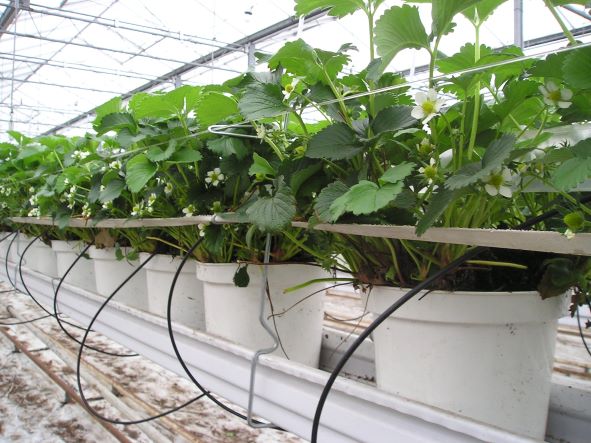
Image © ADAS
These systems typically produce two crops from one planting of a main season variety.
Planting and establishment occurs from late July until mid-August, with the first crop being picked some 60 days later.
The plants are retained over winter for cropping again in spring (April-May).
Harvest timing
The exact timing of harvest in spring depends on whether additional heat and/or night-break lighting has been used.
Where 60-day plants are used later in the season and grown under glass, fruit can be picked through until December.
Less frequently, waiting bed plants are planted during the dormant season for an early spring crop.
These plants will have been allowed to accumulate sufficient chilling and will grow away quickly for an early high-quality crop without the need for night break lighting.
Portable tunnels for field-grown crops
Plantations are established in the field either in the soil (commonly through polythene mulched raised beds) or in bags that are laid on polythene mulched beds/strips.
These are covered with a range of portable polythene tunnel structures to advance cropping from June-July into the earlier May-June period.
In the early years of tunnel production, the structures were used in plantations that had been established the previous year and where high yields were expected.
Rain cover crops
With the increasing requirement by retail customers to cover all crops, two-year old and low yielding plantations are also now covered, but the structures are often not clad until immediately before harvest and are often referred to as ‘rain cover’ crops.
For early production, tunnels are erected in the winter and clad as early as January.
The increased temperatures in the crop environment lead to an increased rate of development and, ultimately, onset of an earlier harvest.
Tunnel types
The type of tunnel chosen affects the earliness of the crop.
French-style tunnels were commonly used in the 1980s and 1990s.
Tunnel hoops are inserted in the soil to allow the polythene to be drawn down to the ground.
French style tunnel drawn to the ground
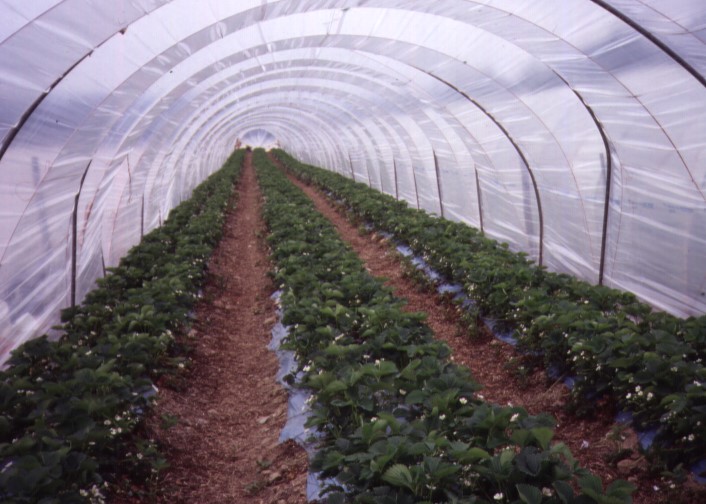 ADAS
ADAS
Image © ADAS
These tend to warm up very quickly, giving rise to a significant advance in harvest.
Leg support system
In recent years, the UK industry has progressed to Spanish-style tunnels, which are multi-bay structures that are erected on a leg support system, raising the tunnels off the ground.
This creates a larger air space above the plants, and a better growing and operating environment.
However, the greater air mass takes longer to warm up in spring. Recent technological advances in Spanish tunnels have overcome this to ensure that cropping can be advanced to the same extent and earlier than French tunnels.
Telescopic tunnels
‘Telescopic’ tunnels have combined the benefits of both ‘French’ and ‘Spanish’ styles. Based on the Spanish design, the hoops can be racked up or down on the leg supports.
Telescopic tunnel
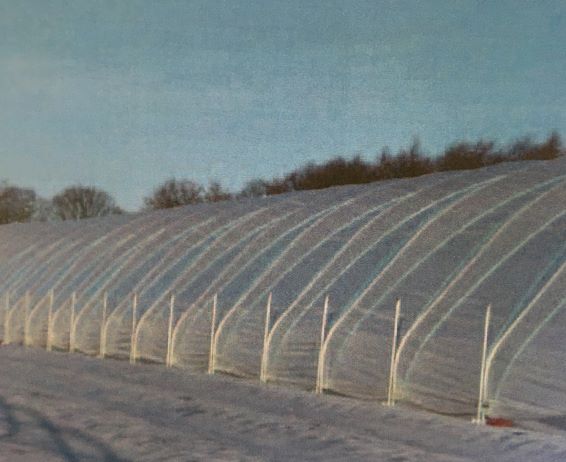
Image © Haygrove Ltd
The hoops are racked down during the spring to provide a lift in temperatures (like the French tunnel), then racked up in late spring and summer as outdoor temperatures rise.
New types of tunnel doors and sides have also been developed to improve tunnel sealing and eliminate drafts early in the season.
Simple doors on Spanish tunnels
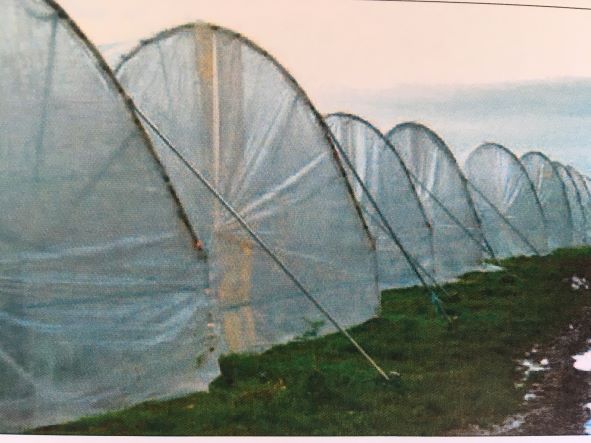
Image © FAST Ltd
Streamline or Nordic doors on Spanish tunnels
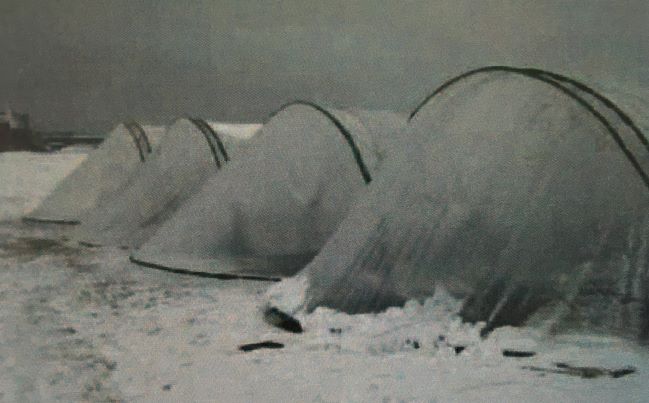
Image © Haygrove Ltd
For maximum earliness, ‘tunnel sealing’ is now recognised as a priority.
Heat retention
While venting may be important during sunny weather, especially in April, at all other times it is important to retain as much heat as possible.
Fully closed doors and polythene sides that are buried in or make close and uniform contact with the ground are essential.
Fleece
To provide an additional advance in the cropping season, plants grown in either type of portable tunnel can be covered by a lay-flat polythene or fleece sheet until the first flowers begin to open.
Such covers are laid on top of the plants either before or at the same time as the tunnels are clad with polythene.
This system, which raises the temperature around the plant leaf even higher, can give a further seven days advance over a structure that does not use additional insulation.
Crop timing
Well ‘sealed’ structures typically start to crop around 14 days earlier than unprotected crops, depending upon the weather and other treatments such as fleece, described later.
The earliest tunnel-grown crops are harvested from fields that combine most or all of the following criteria:
Early micro-climate (South facing, sheltered etc).
- Maiden plants planted out after a period of cold storage.
- Black polythene covered raised beds.
- Strong, well-sealed tunnels that can be clad (or ‘skinned’) during the winter months.
- Light soil texture
Cladding dates are of critical importance.
Cladding before the end of January is advisable but, in addition to a very strong tunnel, such an early date also requires the presence of appropriate staff and management vigilance outside the normal season.
Winter cladding
The risk of gales peaks in the middle of winter, but continues at a high level into March.
For temporary, field scale tunnels the following specifications may be considered to facilitate relatively safe winter cladding:
Stronger steel (2.0–2.5 mm wall thickness, 40 mm diameter and ‘extra strong’ grade).
- ‘Windy End Kits’ or other appropriately strengthened tunnel ends (eg Haygrove SMART ends)
- Closer leg spacings
- Reduced or zero leg height
- Buried sides
- Extra roping
Although the weeks between Christmas and March provide little, if any, growing heat for outdoor crops, there are significant periods of open, sunny weather.
During these periods, the precise timing of which is unpredictable, tunnelled crops can gain several days of valuable earliness.
Portable tunnels for tabletops
Tabletop production is a system from the Netherlands and Belgium, where large volumes of fruit are picked from elevated crops grown under polythene or glass.
Tabletop production allows fruit to be picked at a convenient height for the harvesters

As strawberry pickers find the picking height appealing, the growers in these countries elected to extend this system of production to field sites.
An increasing number of UK growers have been attracted to this system and a range of supporting or tabletop structures are now employed.
In all cases, the systems use soil-less substrates, usually peat and/or coir.
Sixty-day crops
The planting system employed by most growers is similar to that used in glasshouse and fixed tunnel crops.
Sixty-day crops are picked in late summer and the plantation is kept over winter for cropping under tunnels in early summer.
With tabletop systems, high-sided tunnel designs are preferred as these offer greater clearance over the table and easier access to tractor mounted sprayers.
Unfortunately, crops raised above the soil surface start picking 7–10 days later than those grown in the soil under similar covers.
However, by combining naturally early sites with additional investments in strength and heat retention (sealing), which are justified for semi-permanent installations, un-heated tabletop production can still provide very early fruit.
Using film or fleece
In February or early March, a traditional field soil plantation is covered with large sheets of perforated polythene film or woven fleece, which is weighted to avoid lifting in the wind.
Crop covered with perforated polythene film
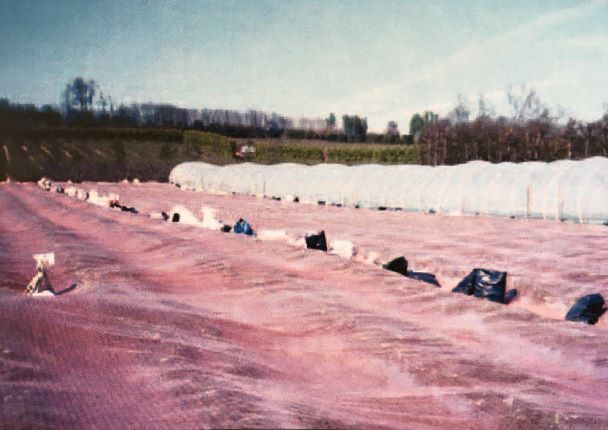
Image © ADAS
Early covering increases the temperatures around the plant, advancing growth and development.
Production speed
In some plantations in certain seasons, temperatures rise so rapidly that crop development can be more advanced than in tunnel crops.
However, to ensure that full pollination takes place it is best to remove the covers before 5% of flowers open, thereby slowing subsequent development.
Lay-flat film or fleece advances cropping by an average of seven days in comparison to unprotected crops.
Original authors
Scott Raffle, AHDB, Robert Irving, ADAS and Graham Moore, FAST Ltd

